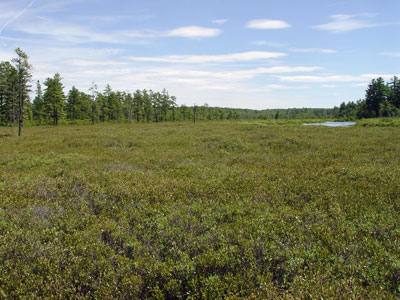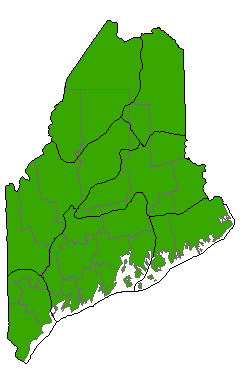DACF Home → Bureaus & Programs → Maine Natural Areas Program → Communities, Plants, and Animals → Natural Community Fact Sheets → Leatherleaf Bog
Printer Friendly Fact Sheet - 830 KB pdf (Get a free copy of Adobe Acrobat Reader)
Leatherleaf Bog
Scientific Name: Leatherleaf Boggy Fen; State Rank: S4

- Community Description
- Soil and Site Characteristics
- Diagnostics
- Similar Types
- Conservation, Wildlife and Management Considerations
- Distribution
- Characteristic Plants
- Associated Rare Plants
- Associated Rare Animals
- Examples on Conservation Lands You Can Visit
Community Description: This peatland vegetation type is dominated by leatherleaf and other low heath shrubs. Most of the vegetation is usually less than 1 m tall, although taller shrubs including black huckleberry, maleberry, and sweetgale may be sporadic. In the dwarf shrub/herb layer, leatherleaf is always present and usually dominant (30-60% cover at most sites). Other heath shrubs and sedges are mixed in with the leatherleaf. Graminoid cover is usually less than 30%. Typical bog plants including pitcher plant, sundew, and small cranberry are scattered on the peat moss substrate. Trees, if present at all, are <15% total cover. Back to top.
Soil and Site Characteristics: This type is common in the wetter parts of bogs and acidic, nutrient poor fens (average pH is 4.0) with peat substrate. It usually occurs in settings where groundwater contact is maintained, and so is technically a fen from a hydrologic standpoint, although it is often referred to as “bog” because of the dominance of heath vegetation. This type is often a major constituent of “kettlehole bog” ecosystems, and it may be present in lakeshore peatlands or other sites with a fluctuating water table. Back to top.
Diagnostics: In a peatland setting, dwarf shrub cover exceeds herb cover, but sheep laurel is not dominant because most sites are hydrologically fens. Tufted cotton-grass and/or tawny cotton-grass are common sedges; white beak-rush is frequent but does not form high cover as it can in other types. Back to top.
Similar Types: This type is intermediate in composition and nutrient regime between a Dwarf Shrub Bog (which is drier and has sheep laurel more abundant) and Sedge - Heath Fen or other graminoid dominated fen community types (which have graminoids more dominant). Back to top.
Conservation, Wildlife and Management Considerations: This type is well represented in Maine and is fairly stable in extent, with several examples on public lands and private conservation lands. Some sites in kettlehole settings have been degraded by adjacent gravel mining. Changes to bog hydrology through impoundment or draining could lead to vegetation changes. Slow vegetation growth rates, due to the nutrient-poor environment, mean slow recovery from physical disturbances, such as recreational trail use. If disturbance, such as foot traffic, is a necessity, traversing during frozen conditions or using boardwalks can minimize impacts.
The ringed boghaunter, a rare dragonfly, is found in this natural community type, especially in very wet locations with abundant inundated peat moss (often suspended in the water column). The ringed boghaunter is restricted to the southern part of the state in York and southern Oxford Counties. Occurrences of this community type in northwestern Maine may include the bog fritillary butterfly, which uses small cranberry as its larval host plant. Occurrences in northern Maine may be inhabited by the subarctic bluet, an uncommon damselfly that inhabits open marshes and fens and reaches the southern edge of its range in northern Maine. Back to top.
Distribution: Statewide; extends in all directions from Maine. Landscape Pattern: Small Patch. Back to top.


Characteristic Plants: These plants are frequently found in this community type. Those with an asterisk are often diagnostic of this community.
- Sapling/shrub
- Black huckleberry*
- Maleberry*
- Dwarf Shrub
- Bog rosemary*
- Leatherleaf*
- Sheep laurel*
- Small cranberry
- Sweetgale*
- Herb
- Beaked sedge*
- Bog aster*
- Few-flowered sedge*
- Pitcher plant*
- Tawny cotton-grass
- Three-leaved false Solomon's seal*
- Tufted cotton-grass*
- White beak-rush*
- Bryoid
- Sphagnum mosses*
- Ringed boghaunter
Examples on Conservation Lands You Can Visit
| Example | County |
|---|---|
| Brownfield Bog Wildlife Management Area | Oxford Co. |
| Great Heath Public Lands | Washington Co. |
| Number Five Bog Public Lands | Somerset Co. |
| Salmon Brook Lake Bog Public Lands | Aroostook Co. |
| Sunkhaze Meadows National Wildlife Refuge | Penobscot Co. |